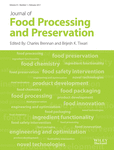Lactobacillus plantarum WCFS1 Fermentation Differentially Affects Antioxidant Capacity and Polyphenol Content in Mung bean (Vigna radiata) and Soya Bean (Glycine max) Milks
Abstract
The antioxidant capacity and polyphenol content in mung bean (Vigna radiata) and soya bean (Glycine max) milk fermented by Lactobacillus plantarum WCFS1 were investigated. Fermentation had different effects on antioxidant capacity in the lipophilic and hydrophilic fractions of two bean milks. Further, the free radical scavenging capacity was much higher in the lipophilic fraction than in the commonly investigated hydrophilic fraction of both fermented bean milks. Total phenolic content in both fermented bean milks increased. HPLC and LC-MS/MS analyses found that vitexin and isovitexin were the main phenolic compounds in the fermented and nonfermented mung bean milk, and fermentation did not significantly change their contents.
Practical Applications
Fermentation of bean milk by lactic acid bacteria (LAB) has been of increasing attraction to food scientists. Herein, we highlighted that LAB Lactobacillus plantarum WCFS1 was efficient for the fermentation of mung bean and soya bean milks, and the two fermented bean milks contained substantial antioxidant polyphenols, especially the fermented mung bean milk, which was rich in vitexin and isovitexin, two flavones with a number of bioactivities. Therefore, L. plantarum WCFS1 can be a good candidate for the fermentation of edible bean milks and fermented bean milks containing antioxidant polyphenols can be developed into functional drinks with enhanced health benefits.




